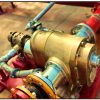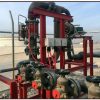Rescue-Operational Robots
Rescue-Operational Robots : Today, the use of robots in all industries is increasing rapidly, and despite the progress made in artificial intelligence, robots are even able to analyze the events around them. Robots in the firefighting, safety and rescue industry are designed and built with the aim of reducing operational risks for operational forces as well as injured persons
**
 **
**
The role of robots in such operations is increasing exponentially and the future of this industry is tied to robots.
You can read the Attached File for more information.
**

**
These robots are divided into two categories of internal combustion engines (mainly diesel) and brush-less electric engines in terms of driving forces. Electric models have the possibility of receiving explosion-proof approvals from international authorities to be present in refinery and petrochemical operations and in areas where there are explosive or combustible gases.
**

**
Robots are divided into two categories according to the type of control.
Remote control robots: These robots, with the command of the user through the control cable and joystick, can be present and play a role in multiple processes.
Automatic robots : These robots, using artificial intelligence, participate in operations and do things like fire fighting and inspections. Here is some examples of robots that have come out of the research and development stages and are widely used in the world are introduced:
**

**
Firefighter robots, progressive and intelligent
These examples are considered the most widely used robots, which mainly have electric motors and remote control. The stability of the control and movement systems are considered important in the construction of these robots.
Some of these types of robots are redesigns of military robots that have high movement capabilities and durable construction quality. Among the important things in choosing these robots are dimensions and size, traction power, ability to cross obstacles, ability to cross water, charging rate, possibility of charging batteries with water flow, control panel board and stability of the robot during use.
Among their other customized features, we can mention gas sensors, thermometer cameras, panoramic cameras, voice commands or hand movements, obstacle and slope detection sensors, etc.
**
Firefighter Robots with High Monitor Capacity
These robots are designed based on the previous batch. With the difference that it has much larger dimensions, monitors with high discharge for large fires, the ability to pass through uneven obstacles and water, very high tensile strength and longer operating time than the first type.
**

**
Air Blowing, Water Mist and Bulldozer Robots
This category mainly has very large dimensions and are usually used in rescue and relief operations in tunnels, oil wells and extensive fires, dilution of toxic gases and moving heavy objects at the scene of the accident. Having an air turbine with the ability to change its position and with a high capacity, water dust production (water mist technology), smoke evacuation and fire extinguishing using water and foam monitors are among the features of these robots.
**

**
Automatic Fire Fighting Robots
In some cases, it is possible to use automatic fire extinguishing robots in refinery sites or reducing electrical pressure or warehouses. These robots, with the cooperation of inspection robots or fire detection and notification systems, after the occurrence of a fire, by connecting fire hoses to themselves, go to the scene of the accident and start extinguishing operations. d. At the end, by separating the hoses from itself, it will return to the hangar and start charging the batteries for the upcoming operations. Artificial intelligence, along with the things mentioned in the first paragraph, is one of their main features.
**

**
Automatic Inspection Robots
The robots of this group are mainly designed and built on the basis of advanced artificial intelligence. Their work is to move continuously along the designated routes in refinery, petrochemical and power plant sites in order to determine the existing situation. Among their features: the ability to read indicators, such as pressure gauges, detecting the status of valves, smart gas meters, smart thermometers, detecting unusual sounds, taking pictures with powerful cameras and analyzing observations, Image Processing, automatic battery charging. Ha, sending the report of every inspection and The announcement is unusual.
**

**
Drone Robots
This group were the first robots that were used in operations and are being developed and updated very quickly. UAV robots are mainly divided into two groups: fire fighting and surveillance robots. The quality of the cameras, the type of extinguishing system, the flight range, the operation time, the carrying capacity, the tolerable temperature, the ability to operate in the sky, scratches and passing through obstacles, are important and important issues in this group.
**

**
Submarine Robots
Generally, carrying out inspection and identification processes in the depth of water is risky and expensive. The robots of this category are able to perform operations at depths of over 300 meters, and by having sonar radars and special cameras, they allow the user to accurately send the current situation.
**

**
**
**
**





